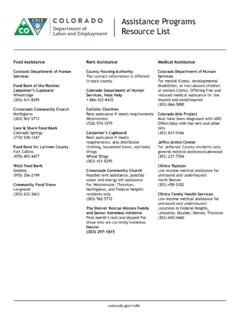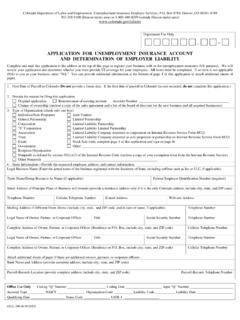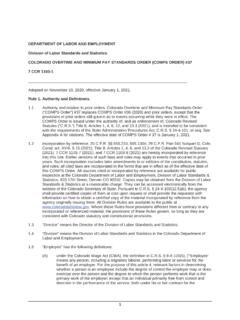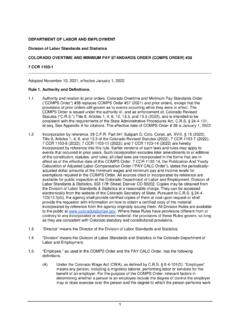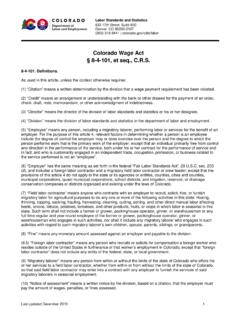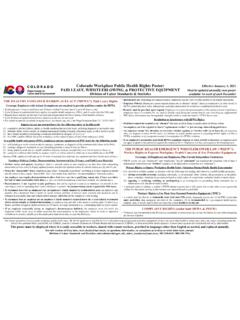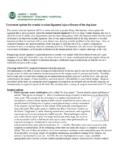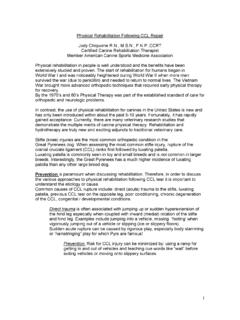Transcription of Lower Extremity Injury Medical Treatment Guidelines
1 RULE 17, EXHIBIT 6 Lower Extremity Injury Medical Treatment Guidelines Revised: January 19, 2016 Effective: March 16, 2016 Adopted: January 9, 1995 Effective: March 2, 1995 Revised: January 8, 1998 Effective: March 15, 1998 Revised: October 4, 2001 Effective: December 1, 2001 Revised: September 29, 2005 Effective: January 1, 2006 Revised: April 26, 2007 Effective: July 1, 2007 Revised: June 24, 2009 Effective: September 1, 2009 Presented by: State of Colorado Department of Labor and Employment DIVISION OF WORKERS' COMPENSATION TABLE OF CONTENTS SECTION DESCRIPTION PAGE A. INTRODUCTION .. 1 B. GENERAL Guidelines PRINCIPLES .. 2 1. APPLICATION OF THE Guidelines : .. 2 2. EDUCATION: .. 2 3. INFORMED DECISION MAKING: .. 2 4. Treatment PARAMETER DURATION: .. 2 5.
2 ACTIVE INTERVENTIONS: .. 2 6. ACTIVE THERAPEUTIC EXERCISE PROGRAM: .. 2 7. POSITIVE PATIENT RESPONSE: .. 2 8. RE-EVALUATE Treatment EVERY 3 TO 4 WEEKS: .. 3 9. SURGICAL INTERVENTIONS: .. 3 10. SIX-MONTH TIME FRAME: .. 3 11. RETURN-TO-WORK:.. 3 12. DELAYED RECOVERY: .. 3 13. Guidelines RECOMMENDATIONS AND INCLUSION OF Medical EVIDENCE: .. 3 14. CARE BEYOND MAXIMUM Medical IMPROVEMENT (MMI): .. 4 C. INITIAL DIAGNOSTIC PROCEDURES .. 5 1. HISTORY-TAKING AND PHYSICAL EXAMINATION (HX & PE) .. 5 a. History of Present Injury .. 5 b. Past History .. 6 c. Physical Examination .. 7 2. RADIOGRAPHIC IMAGING .. 10 3. LABORATORY TESTING .. 11 4. OTHER PROCEDURES .. 11 a. Joint 11 D. FOLLOW-UP DIAGNOSTIC IMAGING AND TESTING PROCEDURES .. 13 1. IMAGING STUDIES .. 13 a. Magnetic Resonance Imaging (MRI).
3 13 b. MR Arthrography (MRA) .. 14 c. Computed Axial Tomography (CT) .. 14 d. Diagnostic Sonography .. 14 e. Lineal Tomography .. 14 f. Bone Scan (Radioisotope Bone Scanning) .. 14 g. Other Radionuclide Scanning .. 14 h. Arthrogram .. 14 2. OTHER DIAGNOSTIC TESTS .. 14 a. Compartment Pressure Testing and Measurement Devices .. 15 b. Doppler Ultrasonography/Plethysmography .. 15 c. Electrodiagnostic Testing .. 15 d. Personality/Psychological/Psychosocial Evaluations .. 15 e. Venogram/Arteriogram .. 16 3. SPECIAL TESTS .. 16 a. Computer-Enhanced Evaluations .. 16 b. Functional Capacity Evaluation (FCE) .. 16 c. Jobsite Evaluation .. 17 d. Vocational Assessment .. 18 e. Work Tolerance Screening (Fitness for Duty) .. 18 E. SPECIFIC Lower Extremity Injury DIAGNOSIS, TESTING, AND Treatment .
4 19 1. FOOT AND ANKLE .. 19 a. Achilles Tendinopathy/or Injury and Rupture .. 19 b. Aggravated Osteoarthritis .. 24 c. Ankle or Subtalar Joint Dislocation .. 28 d. Ankle Sprain/Fracture .. 29 e. Calcaneal Fracture .. 35 f. Chondral and Osteochondral Defects .. 38 g. Metatarsal-Phalangeal, Tarsal-Metatarsal and Interphalangeal Joint Arthropathy .. 40 h. Midfoot (Lisfranc) Fracture/Dislocation .. 43 i. Morton s 46 j. Pilon Fracture .. 48 k. Plantar Fasciitis/Plantar Fasciopathy/Plantar Fasciosis (aka Heel Spur Syndrome, or Chronic Plantar Heel Pain) .. 50 l. Posterior Tibial Tendon Dysfunction .. 56 m. Puncture Wounds of the Foot .. 58 n. Severe Soft Tissue Crush Injuries .. 59 o. Stress 61 p. Talar Fracture .. 63 q. Tarsal Tunnel Syndrome .. 65 r. Tendinopathy .. 67 2.
5 KNEE .. 67 a. Aggravated Osteoarthritis (OA) .. 67 b. Anterior Cruciate Ligament (ACL) Injury .. 75 c. Bursitis of the Lower Extremity .. 81 d. Chondral and Osteochondral Defects .. 83 e. Collateral Ligament Pathology .. 88 f. Meniscus Injury .. 90 g. Patellar 94 h. Patellar Subluxation .. 97 i. Patellofemoral Pain Syndrome (aka Retropatellar Pain Syndrome) and Patellar Tendinopathy .. 99 j. Posterior Cruciate Ligament (PCL) Injury .. 103 k. Tendinopathy .. 106 3. HIP AND LEG .. 108 a. Acetabular Fracture .. 109 b. Aggravated Osteoarthritis .. 111 c. Femoral Osteonecrosis (Avascular Necrosis (AVN) of the Femoral Head) .. 115 d. Femur Fracture .. 118 e. Hamstring Tendon Rupture .. 120 f. Hip Dislocation .. 122 g. Hip Fracture .. 124 h. Impingement/Labral Tears .. 127 i.
6 Pelvic Fracture .. 130 j. Tendinopathy .. 133 k. Tibial Fracture .. 133 l. Trochanteric Fracture .. 137 F. THERAPEUTIC PROCEDURES NON-OPERATIVE .. 141 1. ACUPUNCTURE: .. 141 a. Acupuncture .. 143 b. Acupuncture with Electrical Stimulation .. 143 c. Total Time Frames for Acupuncture and Acupuncture with Electrical Stimulation .. 143 d. Other Acupuncture Modalities .. 144 2. BIOFEEDBACK: .. 144 3. BONE-GROWTH STIMULATORS .. 144 a. Electrical .. 144 b. Low-intensity Pulsed Ultrasound (LIPUS) .. 145 4. EDUCATION/INFORMED DECISION MAKING .. 145 5. EXTRACORPOREAL SHOCK WAVE THERAPY (ESWT) .. 146 6. INJECTIONS-THERAPEUTIC .. 147 a. Steroid 147 b. Soft Tissue Injections .. 149 c. Stem Cell Injections .. 149 d. Platelet Rich Plasma (PRP): .. 150 e. Viscosupplementation/Intracapsular Acid Salts.
7 151 f. Prolotherapy .. 152 g. Trigger Point Injections & Dry Needling .. 152 h. Botulinum Toxin Injections .. 153 7. INTERDISCIPLINARY .. 154 a. Formal Interdisciplinary Rehabilitation Programs .. 156 b. Informal Interdisciplinary Rehabilitation Program .. 158 8. JOBSITE ALTERATION .. 158 a. Ergonomic Changes .. 159 b. Interventions .. 159 9. MEDICATIONS AND Medical MANAGEMENT .. 159 a. Acetaminophen .. 160 b. 160 c. Deep Venous Thrombosis (DVT) Prophylaxis .. 160 d. Doxycycline .. 162 e. Minor Tranquilizer/Muscle Relaxants .. 162 f. Nonsteroidal Anti-Inflammatory Drugs (NSAIDs) .. 162 g. Opioids .. 163 h. Oral Steroids .. 164 i. Osteoporosis Management .. 164 j. Psychotropic/Anti-anxiety/Hypnotic Agents .. 165 k. Topical Drug Delivery .. 166 l. Tramadol .. 167 m. Tranexamic Acid.
8 167 10. OCCUPATIONAL REHABILITATION PROGRAMS .. 167 a. Non-Interdisciplinary .. 167 11. ORTHOTICS AND PROSTHETICS .. 168 a. Fabrication/Modification of 168 b. Orthotic/Prosthetic Training .. 169 c. Splints or Adaptive Equipment .. 170 12. PERSONALITY/PSYCHOSOCIAL/PSYCHOLOGICAL INTERVENTION .. 170 a. Cognitive Behavioral Therapy (CBT) or Similar Treatment .. 172 b. Other Psychological/Psychiatric Interventions .. 172 13. RESTRICTION OF ACTIVITIES .. 172 14. 173 a. Job History Interview .. 173 b. Coordination of Care .. 173 c. Communication .. 174 d. Establishment of Return-to-Work Status .. 174 e. Establishment of Activity Level Restrictions .. 174 f. Rehabilitation and Return to Work .. 174 g. Vocational Assistance .. 174 15. THERAPY-ACTIVE .. 175 a. Activities of Daily Living (ADL).
9 175 b. Aquatic Therapy .. 176 c. Functional Activities .. 177 d. Functional Electrical Stimulation .. 177 e. Gait Training .. 177 f. Neuromuscular Re-education .. 177 g. Therapeutic Exercise .. 178 h. Wheelchair Management and Propulsion .. 179 16. 179 a. Continuous Passive Motion (CPM) .. 179 b. Contrast Baths .. 180 c. Dynamic Splinting .. 180 d. Electrical Stimulation (Unattended).. 180 e. Fluidotherapy .. 181 f. Hyperbaric Oxygen Therapy .. 181 g. Infrared 181 h. Iontophoresis .. 181 i. Manipulation .. 182 j. Manual Electrical Stimulation .. 182 k. Massage Manual or 183 l. Mobilization (Joint) .. 183 m. Mobilization (Soft Tissue) .. 183 n. Paraffin Bath .. 184 o. Superficial Heat and Cold Therapy .. 184 p. Short-wave Diathermy .. 184 q. Traction .. 185 r. Transcutaneous Electrical Nerve Stimulation (TENS).
10 185 s. Ultrasound .. 185 t. Vasopneumatic Devices .. 186 17. VOCATIONAL REHABILITATION .. 186 G. THERAPEUTIC PROCEDURES OPERATIVE .. 187 1. ANKLE AND SUBTALAR FUSION .. 187 2. KNEE FUSION .. 189 3. ANKLE ARTHROPLASTY .. 191 4. KNEE ARTHROPLASTY .. 193 5. HIP ARTHROPLASTY .. 199 6. AMPUTATION .. 203 7. MANIPULATION UNDER ANESTHESIA .. 205 8. OSTEOTOMY .. 206 9. HARDWARE REMOVAL .. 208 10. RELEASE OF CONTRACTURE .. 209 11. HUMAN BONE MORPHOGENETIC PROTEIN (RHBMP) .. 211 Lower Extremity Injury Exhibit Page Number 1 DEPARTMENT OF LABOR AND EMPLOYMENT Division of Workers Compensation CCR 1101-3 RULE 17, EXHIBIT 6 Lower Extremity Injury Medical Treatment Guidelines A. INTRODUCTION This document has been prepared by the Colorado Department of Labor and Employment, Division of Workers Compensation (Division) and should be interpreted within the context of providers treating individuals qualifying under Colorado Workers Compensation Act as injured workers with Lower Extremity injuries.
